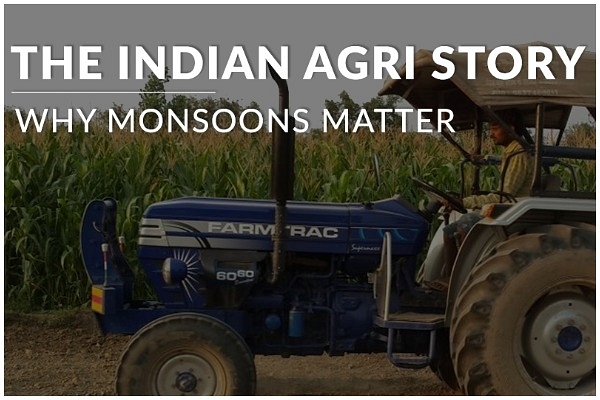Videos
The Indian Agri Story: Why Monsoon Rains Are Critical

A tractor in an agricultural field.
Transcript
This, behind me, is the kind of picture you are probably familiar with. Or at least, you know what’s being indicated here. Such is the impact that the monsoon - or the lack of it, as depicted in the picture - can have on India - and in particular, Indian agriculture.
But why is that the case? Why are the monsoons so critical in India?
Let’s look at the basics.
We have a couple of types of monsoons in India - one is the south-west kind… that pours from June to September… and the other is the north-east kind, extending from September to October. About 75 per cent of all the rainfall we get in a year comes from the south-west winds.
And we should be thankful for the rains! Because about 48 per cent of the food crop area depends on the rains, while that number is even higher for non-food-crop area - at 68 per cent.
The south-west monsoon gathers form - a little like Rohit Sharma in this cricket world cup - during the months of June, July, and August.
Now that’s the rain bit. What about agriculture seasons?
Here again, there are two - kharif and rabi. Kharif is the summer crop for which sowing begins around June and harvest is done in October. Rabi is the winter crop with sowing kicking off in December and harvest throwing returns in April.
With that out of the way, let’s look at what’s been the monsoon situation in India. What we’ve got over the years is near-normal amount of rainfall every year - yet, since 2013, some parts of the country have received deficient rainfall - and that’s been an issue.
Because it’s not enough to have normal monsoons alone - what is also required is even and widespread rainfall.
Let me illustrate this quickly with one example. In 2017, Tamil Nadu received excess rainfall owing to the south-west monsoon. But that had little impact on agriculture production because the state depends more on the north-east monsoon, which starts in October.
Similarly, a normal amount of rainfall with heavy pouring in September doesn’t help, as the crop would have been starved of water during July-August. Although this scenario can help in one way - it can improve the soil moisture for the rabi crop - which is exactly what we’ve seen happen in recent years.
Again, normal rains during the rainy season need not necessarily be enough. Rains before the monsoons can help improve soil moisture, in turn improving the prospects of a crop. All the coffee lovers out there - coffee production gets affected quite a bit if there is deficient pre-monsoon rainfall.
And that’s a lesson right there on how the monsoon affects Indian agriculture.
And now, just think if we have a good rain year. Nearly 60 per cent of India’s rural households depend on agriculture, so they will reap the benefits of it. A good crop that goes for a good price would mean that farmers will have more money to spend - and when they do that, you get a good, buoyant rural economy. This obviously positively impacts the Indian economy as a whole.
But what we instead got last year was 9 per cent less monsoon rainfall than normal. And this is what is expected this year as well, with private forecaster Skymet predicting below-normal rainfall this year.
But well, now you know what the implications of that could be.
We have more videos coming up for you around the theme of Indian agriculture - what affects it, what doesn’t, what needs to be done, and so on… All we request of you is, like and share our video, and subscribe to our channel - there are plenty of things under the sky to discuss on video - even when it’s raining outside.
Introducing ElectionsHQ + 50 Ground Reports Project
The 2024 elections might seem easy to guess, but there are some important questions that shouldn't be missed.
Do freebies still sway voters? Do people prioritise infrastructure when voting? How will Punjab vote?
The answers to these questions provide great insights into where we, as a country, are headed in the years to come.
Swarajya is starting a project with an aim to do 50 solid ground stories and a smart commentary service on WhatsApp, a one-of-a-kind. We'd love your support during this election season.
Click below to contribute.
Latest